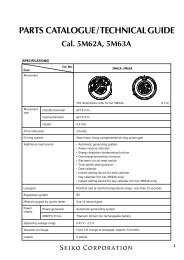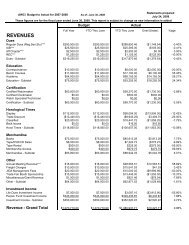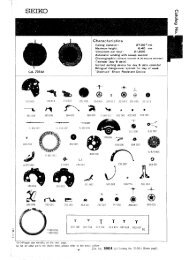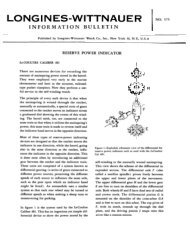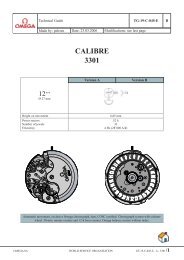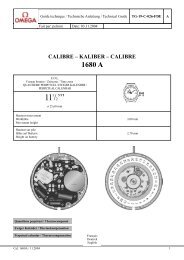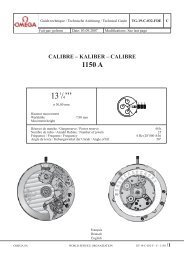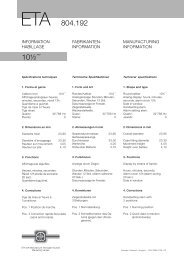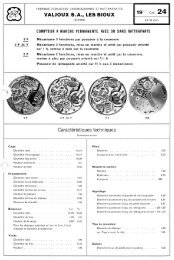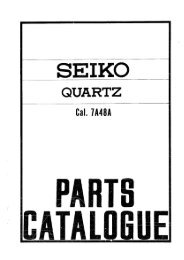PDF Version - The American Watchmakers-Clockmakers Institute
PDF Version - The American Watchmakers-Clockmakers Institute
PDF Version - The American Watchmakers-Clockmakers Institute
You also want an ePaper? Increase the reach of your titles
YUMPU automatically turns print PDFs into web optimized ePapers that Google loves.
Your Education and the S&P’s<br />
By jerry faier, cmc21<br />
is unimportant. What that material tells you is what<br />
we expect of any bench professional when they are<br />
servicing a watch. <strong>The</strong> first sections deal with proficiencies.<br />
<strong>The</strong>y set the standard for readiness of yourself<br />
and your equipment. One point here to consider<br />
is: Can you perform all these points If you don’t<br />
have the necessary equipment to do the job and to<br />
service your tools in order to return them to readiness<br />
for the next job, then it’s time to evaluate what<br />
you are doing and examine your equipment. Design<br />
a plan to replace old worn equipment and arrange<br />
for the purchase of new materials. It may break the<br />
bank to buy all you need at once, but by adding new<br />
equipment gradually, it becomes doable.<br />
<strong>The</strong> next sections deal with specific types of watch<br />
products: Electronic/quartz, mechanical, and chronographs.<br />
Each section breaks down the specific behaviors<br />
a professional must possess. Your task is to<br />
test yourself on each item to see if you can perform<br />
it properly and completely. How’s your knowledge<br />
of quartz theory, current consumption, or coil resistance<br />
How many other terms are used to define the<br />
proper use of battery power in a quartz watch Are<br />
you up-to-date on the general principles of the common<br />
analogue and digital modules that are sold Get<br />
a current movement catalogue from a supplier and<br />
test your knowledge. Next, find a module you can<br />
test yourself on and tear it down. Check every feature<br />
discussed in the “Service Procedures” and be<br />
sure you can define all the terminology that comes<br />
along with it. Next, tear the movement down again.<br />
Only this time, use a stop watch to see how long it<br />
takes you to complete the tear down, re-assemble, oil<br />
and adjust the movement and re-case it. Try another<br />
under the timing routine and see if you can improve<br />
your time without losing a step. When I work on a<br />
product for the first time, I work for accuracy. <strong>The</strong><br />
next trial is for efficiency, and all the future times I try<br />
for entering and exiting without leaving any marks<br />
or evidence that anyone other than the factory was<br />
ever there. That may include correcting mistakes<br />
made by others, but certainly includes being extra<br />
careful to make it as perfect as possible with no lint,<br />
dirt, crumbs or markings of any kind left behind. It<br />
is this timed discipline that will direct you into more<br />
efficiency and less effort when you encounter these<br />
types of movements.<br />
Don’t forget the water testing. Can you define the<br />
difference between water proof and water resistant<br />
How do we prepare a case for each How was the<br />
case prepared for the watch you are working with<br />
at the moment Do you have a proper tester Do<br />
you know how to service the tester so your results<br />
are correct <strong>The</strong>se are all skills to practice that will<br />
help you improve the speed of your work, improve<br />
your efficiency, and improve your bottom line. We’ll<br />
look at more details next month on these types of<br />
watches.<br />
If you have a fellow watchmaker you visit with from<br />
time to time, an excellent activity to sharpen your<br />
knowledge and help key in your service skills is to<br />
trade questions about some aspect of the service<br />
process with this type of watch. For example, the<br />
customer brings back in a quartz watch you serviced<br />
about 2 months earlier. <strong>The</strong> watch doesn’t seem to<br />
keep accurate time. First, what diagnostics can you<br />
perform without taking the watch apart or out of the<br />
case to determine what may be going wrong List<br />
all the reasons that could make this timing problem<br />
happen, why they may be the possible reasons for<br />
this occurrence and what you would do to correct<br />
each option. <strong>The</strong> certification assessment follows<br />
similar approaches. It’s what a competent bench<br />
person will do every day for their living. I used to call<br />
this “play time fun at the shop!” It builds skills and<br />
confidence, as well.<br />
<strong>The</strong> Clock S & P<br />
<strong>Clockmakers</strong>, check out page 20 of the Clock S&P.<br />
Why do we suggest that a movement be torn down<br />
before cleaning Could it be because you are flirting<br />
with disaster if you don’t tear them down after you<br />
have removed them for cleaning Why Capillary action<br />
is not just something you can choose to forget<br />
after you left high school. Physics works and only a<br />
fool will try to violate its principles. You can mess<br />
Horological Times December 2010 26





